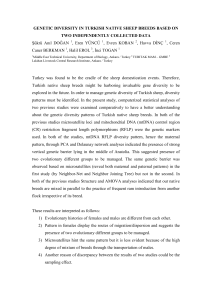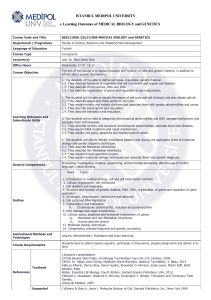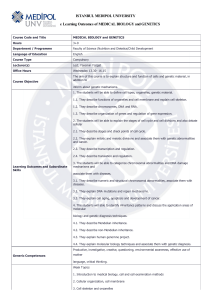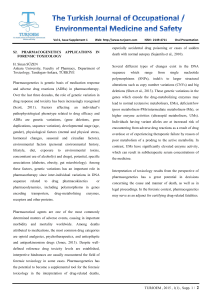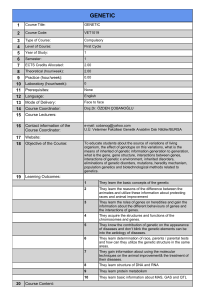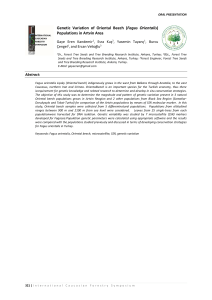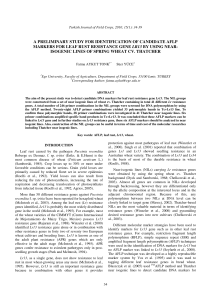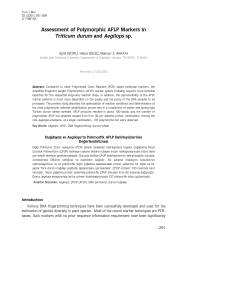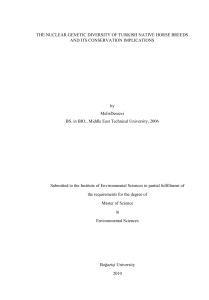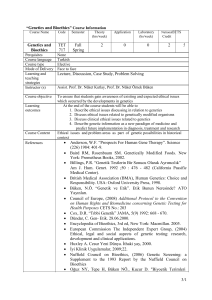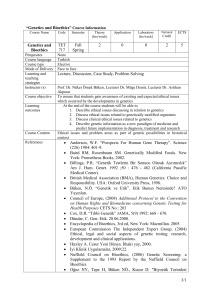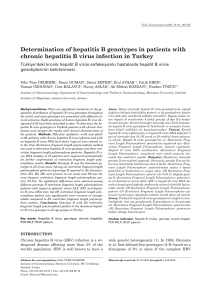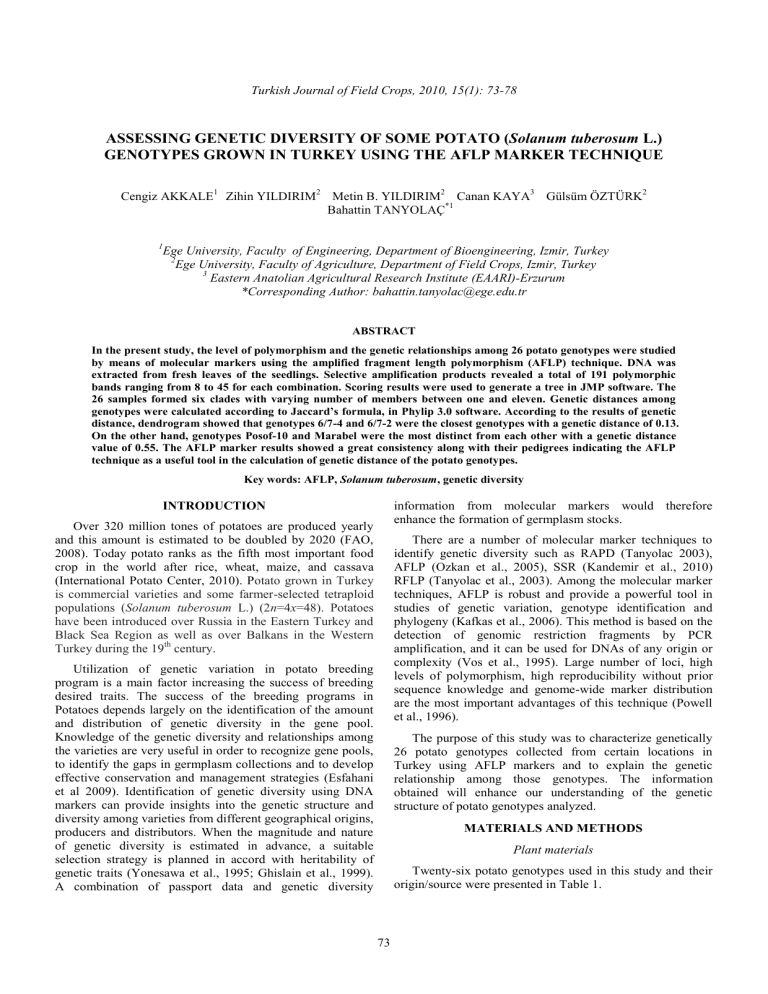
Turkish Journal of Field Crops, 2010, 15(1): 73-78
ASSESSING GENETIC DIVERSITY OF SOME POTATO (Solanum tuberosum L.)
GENOTYPES GROWN IN TURKEY USING THE AFLP MARKER TECHNIQUE
Cengiz AKKALE1 Zihin YILDIRIM2 Metin B. YILDIRIM2 Canan KAYA3 Gülsüm ÖZTÜRK2
Bahattin TANYOLAÇ*1
1
Ege University, Faculty of Engineering, Department of Bioengineering, Izmir, Turkey
2
Ege University, Faculty of Agriculture, Department of Field Crops, Izmir, Turkey
3
Eastern Anatolian Agricultural Research Institute (EAARI)-Erzurum
*Corresponding Author: [email protected]
ABSTRACT
In the present study, the level of polymorphism and the genetic relationships among 26 potato genotypes were studied
by means of molecular markers using the amplified fragment length polymorphism (AFLP) technique. DNA was
extracted from fresh leaves of the seedlings. Selective amplification products revealed a total of 191 polymorphic
bands ranging from 8 to 45 for each combination. Scoring results were used to generate a tree in JMP software. The
26 samples formed six clades with varying number of members between one and eleven. Genetic distances among
genotypes were calculated according to Jaccard’s formula, in Phylip 3.0 software. According to the results of genetic
distance, dendrogram showed that genotypes 6/7-4 and 6/7-2 were the closest genotypes with a genetic distance of 0.13.
On the other hand, genotypes Posof-10 and Marabel were the most distinct from each other with a genetic distance
value of 0.55. The AFLP marker results showed a great consistency along with their pedigrees indicating the AFLP
technique as a useful tool in the calculation of genetic distance of the potato genotypes.
Key words: AFLP, Solanum tuberosum, genetic diversity
information from molecular markers would therefore
enhance the formation of germplasm stocks.
INTRODUCTION
Over 320 million tones of potatoes are produced yearly
and this amount is estimated to be doubled by 2020 (FAO,
2008). Today potato ranks as the fifth most important food
crop in the world after rice, wheat, maize, and cassava
(International Potato Center, 2010). Potato grown in Turkey
is commercial varieties and some farmer-selected tetraploid
populations (Solanum tuberosum L.) (2n=4x=48). Potatoes
have been introduced over Russia in the Eastern Turkey and
Black Sea Region as well as over Balkans in the Western
Turkey during the 19th century.
There are a number of molecular marker techniques to
identify genetic diversity such as RAPD (Tanyolac 2003),
AFLP (Ozkan et al., 2005), SSR (Kandemir et al., 2010)
RFLP (Tanyolac et al., 2003). Among the molecular marker
techniques, AFLP is robust and provide a powerful tool in
studies of genetic variation, genotype identification and
phylogeny (Kafkas et al., 2006). This method is based on the
detection of genomic restriction fragments by PCR
amplification, and it can be used for DNAs of any origin or
complexity (Vos et al., 1995). Large number of loci, high
levels of polymorphism, high reproducibility without prior
sequence knowledge and genome-wide marker distribution
are the most important advantages of this technique (Powell
et al., 1996).
Utilization of genetic variation in potato breeding
program is a main factor increasing the success of breeding
desired traits. The success of the breeding programs in
Potatoes depends largely on the identification of the amount
and distribution of genetic diversity in the gene pool.
Knowledge of the genetic diversity and relationships among
the varieties are very useful in order to recognize gene pools,
to identify the gaps in germplasm collections and to develop
effective conservation and management strategies (Esfahani
et al 2009). Identification of genetic diversity using DNA
markers can provide insights into the genetic structure and
diversity among varieties from different geographical origins,
producers and distributors. When the magnitude and nature
of genetic diversity is estimated in advance, a suitable
selection strategy is planned in accord with heritability of
genetic traits (Yonesawa et al., 1995; Ghislain et al., 1999).
A combination of passport data and genetic diversity
The purpose of this study was to characterize genetically
26 potato genotypes collected from certain locations in
Turkey using AFLP markers and to explain the genetic
relationship among those genotypes. The information
obtained will enhance our understanding of the genetic
structure of potato genotypes analyzed.
MATERIALS AND METHODS
Plant materials
Twenty-six potato genotypes used in this study and their
origin/source were presented in Table 1.
73
Table 1. Potato genotypes used in this study and their origin.
Sample
code
1
2
3
4
5
6
7
8
9
10
11
12
13
14
15
16
Variety/clone name
Origin/Source
Hybrid 93448-15 (Granola x Baraca)
Hybrid 93448-6 (Granola x Baraca)
Samki-15 Land race population
Samki-17 Land race population
Posof Central-15 Land race population
Posof Central -16 Land race population
Posof-10 Land race population
Posof-9 Land race population
ABK-10 (Alabalik) Land race population
ABK-15 (Alabalik) Land race population
DC-11 (Dogrucan) Land race population
DD-25 (Dogrucan) Land race population
CY-1 (Camyazi) Land race population
CY-19 (Camyazi) Land race population
106-1 (R.143xCosima)
106-5 (R.143xCosima)
(EAARI-Erzurum ) Selection
(EAARI-Erzurum) Selection
Local selection (EAARI-Erzurum)
Local selection (EAARI-Erzurum)
Local selection (EAARI-Erzurum)
Local selection (EAARI-Erzurum)
Local selection (EAARI-Erzurum)
Local selection (EAARI-Erzurum)
Local selection (EAARI-Erzurum)
Local selection (EAARI-Erzurum)
Local selection (EAARI-Erzurum)
Local selection (EAARI-Erzurum)
Local selection (EAARI-Erzurum)
Local selection (EAARI-Erzurum)
Dept of Field Crops, Ege University
Dept of Field Crops, Ege University
Dept of Field Crops, Ege University (FDR
mechanism)
Dept of Field Crops, Ege University (FDR
mechanism)
Dept of Field Crops Ege University
Dept of Field Crops Ege University
Dept of Field Crops Ege University
Dept of Field Crops Ege University
Aegean Agricultural Research Institute
(AARI)-Izmir Turkey
(AARI)
(AARI)
(AARI)
17
6/7-4 (Merrimack x DTO17)
18
6/7-2 (Merrimack x DTO17)
19
20
21
22
Nif-1 (R.143xCosima)
Nif-3 (R.143xCosima)
122-5 (R.143xCosima)
122-1 (R.143xCosima)
23
Granola
24
25
26
Marabel
Agria
Marfona
diluted 1:40 and unused portions were stored at -20° C. Six
different fluorescent labeled selective primer combinations,
MCAA-EAAG, MCAA-EACG, MCAG-EAAC, MCAGEACT, MCAA-EAAC, MCAA-EAGC, were used for
selective amplification. Thermal cycler was set to 13 cycles
of 30 s at 94° C, 30 s at 65° C (with decrements of 0.7° C at
each cycle), 1 min at 72° C and 23 cycles of 30 s at 94° C, 30
s at 56° C 1 min at 72° C and a storage step at 4° C forever.
Selective amplification products were resolved in 8%
polyacrylamide gel under 1500 V and 40 mA of current at
45° C for 3.5 hours. Fluorescent labeled PCR products were
visualized in Li-Cor 4300s DNA analyzer. Gel images
(Figure 1) were then transferred from SAGA software in
DNA analyzer into computer and used for scoring of the
samples for the presence or absence of the polymorphic
bands.
DNA Extraction
Doyle (1990) from fresh, young leaves of seedlings. DNA
concentrations of each sample were measured in NanoDrop1000 spectrophotometer (Thermo Co.).
AFLP Analysis
Licor AFLP kit (cat no: 829-06195) was used for AFLP
technique. Manufacturer recommendations were followed for
digestion, pre-amplification and selective amplification.
Isolated DNA samples were diluted to 40 ng/μl. The genomic
DNA (100 ng) was restricted with EcoR I/Mse I enzyme mix
in a volume of 12.5 μl containing 1.25 units of each enzyme.
After incubation of the mixture at 37° C for 2 hours, an
enzyme inactivation step was applied for 15 minutes at 70° C.
Adapter mix and 2.5 units of T4 DNA ligase was added to
the mixture and ligation was performed at 20° C for 2 hours.
After 1:10 dilution of the ligation product, a preamplification step was carried out with the primers from the
Li-Cor AFLP® Template Preparation Kit.
Genetic distance (GD) calculation
The polymorphic bands were scored as 1 for presence of
the bands and 0 for absence of the bands in Microsoft Excel
software. JMP 3.0 software was used to generate a
dendrogram among 26 samples according to UPGMA
method with the scored matrix. The pairwise comparisons of
Thermal cycler (PTC 225, MJ Research) was set to 20
cycles of 30 s at 94° C, 1 min at 56° C, and 1 min at 72° C,
and store at 4° C. Five μl of pre-amplification products were
74
Table 2. Genetic distance values of 26 genotypes calculated according to Jaccard’s formula (The numbers (1 to 26) indicate sample code in
Table 1 and the numbers in bold indicate max and min GD values).
01.
02.
03.
04.
05.
06.
07.
08.
09.
10.
11.
12.
13.
14.
15.
16.
17.
18.
19.
20.
21.
22.
23.
24.
25.
26.
01.
0.00
0.18
0.33
0.34
0.42
0.39
0.42
0.38
0.34
0.33
0.33
0.33
0.35
0.34
0.38
0.39
0.34
0.32
0.28
0.38
0.38
0.42
0.36
0.48
0.37
0.35
02.
03.
04.
05.
06.
07.
08.
09.
10.
11.
12.
13.
14.
15.
16.
17.
18.
19.
20.
21.
22.
23.
24.
25.
26.
0.00
0.27
0.31
0.37
0.35
0.38
0.47
0.30
0.28
0.34
0.27
0.38
0.34
0.36
0.32
0.31
0.28
0.31
0.32
0.30
0.30
0.36
0.50
0.35
0.33
0.00
0.16
0.35
0.37
0.35
0.43
0.41
0.32
0.33
0.29
0.32
0.35
0.35
0.38
0.35
0.28
0.38
0.37
0.33
0.33
0.37
0.51
0.30
0.35
0.00
0.42
0.37
0.37
0.43
0.39
0.28
0.30
0.33
0.36
0.41
0.38
0.38
0.33
0.28
0.39
0.40
0.33
0.35
0.37
0.54
0.33
0.34
0.00
0.38
0.38
0.53
0.46
0.39
0.42
0.30
0.44
0.44
0.45
0.35
0.39
0.34
0.46
0.45
0.42
0.41
0.42
0.54
0.46
0.43
0.00
0.35
0.52
0.40
0.26
0.33
0.35
0.33
0.28
0.38
0.32
0.31
0.28
0.45
0.39
0.36
0.31
0.36
0.52
0.37
0.36
0.00
0.30
0.37
0.33
0.38
0.33
0.43
0.42
0.35
0.41
0.34
0.30
0.48
0.46
0.29
0.33
0.39
0.55
0.45
0.44
0.00
0.43
0.45
0.50
0.40
0.48
0.45
0.35
0.46
0.48
0.44
0.45
0.44
0.44
0.42
0.49
0.55
0.52
0.49
0.00
0.16
0.33
0.35
0.44
0.42
0.40
0.43
0.36
0.35
0.41
0.42
0.28
0.38
0.37
0.51
0.38
0.33
0.00
0.28
0.28
0.29
0.32
0.34
0.35
0.30
0.26
0.33
0.28
0.23
0.25
0.33
0.44
0.30
0.33
0.00
0.30
0.36
0.33
0.38
0.37
0.33
0.30
0.33
0.30
0.30
0.38
0.33
0.44
0.28
0.33
0.00
0.35
0.38
0.35
0.33
0.36
0.31
0.35
0.34
0.31
0.33
0.34
0.51
0.39
0.37
0.00
0.24
0.33
0.35
0.35
0.34
0.38
0.37
0.40
0.38
0.40
0.47
0.35
0.40
0.00
0.27
0.31
0.33
0.27
0.38
0.31
0.35
0.32
0.35
0.51
0.36
0.40
0.00
0.25
0.30
0.29
0.38
0.29
0.28
0.27
0.38
0.52
0.38
0.35
0.00
0.33
0.26
0.38
0.35
0.32
0.30
0.41
0.48
0.37
0.38
0.00
0.13
0.32
0.34
0.28
0.32
0.38
0.46
0.36
0.30
0.00
0.31
0.28
0.21
0.24
0.35
0.46
0.30
0.33
0.00
0.19
0.30
0.33
0.34
0.44
0.36
0.37
0.00
0.25
0.26
0.35
0.50
0.33
0.35
0.00
0.15
0.30
0.46
0.31
0.33
0.00
0.35
0.51
0.38
0.40
0.00
0.55
0.33
0.36
0.00
0.42
0.43
0.00
0.24
0.00
the hybridization fragments were used to calculate GD
according to Jaccard’s formula (1908) in Phylip 3.0 software:
NY: number of bands present in population y and absent in
population x.
GD=1-Nxy/(NXY + NX + Ny)
The Polymorphic Information Content (PIC) for each marker
was calculated according to Anderson (1993) as:
Where:
GD: Genetic distance.
NXY: number of bands common in population x and y.
NX: number of bands present in population x and absent in
population y.
where Pi is the frequency of the ith band and n is the number
of bands observed.
Figure 1. Gel images of AFLP profile obtained from selective primer combinations of M-CAG-E-AAC and M-CAG-E-ACT. M: 50-700bp
ladder
75
Table 3. List of primer combinations used and numbers of polymorphic and monomorphic bands obtained.
Combination
order
1
2
3
4
5
6
Primer
Combination
M-CAA-E-AAG
M-CAA-E-ACG
M-CAA-E-AAC
M-CAA-E-AGC
M-CAG-E-AAC
M-CAG-E-ACT
Total
Number of
Number of
polymorphic monomorphic
bands
bands
39
16
43
6
8
10
23
16
33
17
45
8
191
73
Total
55
49
18
39
50
53
264
PICa
0.59
0.53
0.64
0.68
0.58
0.46
0.56c
Min
PIC
0.12
0.19
0.15
0.04
0.04
0.04
0.10c
Max
PIC
0.96
0.88
0.96
0.96
0.96
0.96
0.95c
POL %b
70.9
87.8
44.4
59.0
66.0
84.9
72.3c
a
PIC: Polymorphic information content.
POL%: percentage of polymorphic bands to total number of bands
Mean values for PIC and POL%.
b
c
primer combination while the highest POL% value (87.8%)
was obtained from primer combination M-CAA-E-ACG and
the lowest one was in the M-CAA-E-AAC primer
combination as well as the lowest POL% value (44.4%).
Presence and absence of the bands were used to calculate
genetic distance (GD) among genotypes (Table 2). The max
GD was calculated as 0.55 between Posof-10 and Marabel
genotypes. The min GD was 0.13 between 6/7-4 and 6/7-2.
RESULTS
A total of 6 primers combination was used and 264 bands
were obtained (Table 3). Out of 264 bands in six primer
combinations gave a total of 191 clearly scorable
polymorphic bands. Some representative gel images were
presented in Fig 1. The average number of polymorphic
bands per primer was 31.5 bands. The polymorphic bands
ratio (POL%) was calculated as an average of 72.3%. The
number of polymorphic bands was ranged from 8 to 45 for
each combination as shown in Table 3. The highest number
of polymorphic bands was obtained in the M-CAG-E-ACT
The average GD was identified as 0.36. The genetic
distance matrix was used to construct a dendrogram for
relationship
Figure 2. A Dendrogram of 26 genotypes constructed in JMP 3.0 software using 191 polymorphic bands.
76
which gave the average POL as 72.3%, while Esfahani et al.
(2009) evaluated POL as 96.14% with 564 polymorphic
bands. Polymorphic information content (PIC) describes
discriminatory power of a polymorphic band by giving the
frequency information of an allele among the genotypes. In
this study, PIC values were distributed between 0.04 and
0.96 with a mean of 0.56 (Table 3) for 191 bands indicating a
diverse distribution of polymorphic information throughout
the bands. In contrast, Esfahani et al. (2009) calculated a
mean value of PIC as 0.61 ranging from 0.48 to 0.72
showing a more uniform distribution of polymorphic bands.
Ispizua et al (2007) found the PIC between 0.88 and 0.92 in
Argentina Potato landraces using SSR markers. The distant
genotypes can be seen on the Fig 1, as Posof Central -15,
Posof-9 and Marabel. For the clades number 1 and 4, average
GD among the clade members was rather low (0.28-0.30)
when compared to the mean GD of all genotypes to each
other (0.36) indicating the strength of the clades. However
GD between genotypes Posof-9 and Marabel was much
higher (0.55) suggesting these genotypes more distant.
Esfahani et al. (2009) determined an unreleased accession to
be distant to the remaining 24 accessions with a GD value of
0.97 but could not find an extreme dissimilarity with other
varieties.
among the genotypes. After construction of the dendrogram,
26 genotypes were grouped in seven clades with varying
members between 1 and 11 (Figure 2). Clade 1 consisted of 4
genotypes: hybrid 93448-15, hybrid 93448-6, Nif–1 and Nif3. Clade 2 included Posof-10, ABK-10 (Alabalik), ABK-15
(Alabalik), DD-25 (Dogrucan), Granola, clone 106-1, clone
122-5, clone 122-1, clone 106-5, clone 6/7-4 and clone 6/7-2.
Genotypes, Posof Central-16, CY-1 (Camyazi) and CY-19
(Camyazı) were in Clade 3. Genotypes: Samki-15, Samki-17,
DC-11 (Dogrucan), Agria and Marfona constituted in the
Clade 4. The genotype Posof Central-15, Posof 9 and
Marabel formed Clades 5, 6 and 7 individually. Among the
commercial varieties used in this study, Agria and Marfona
seemed to be close to each other and the rest of genotypes
formed relatively close relationship with the Turkish local
genotypes.
Table 4. Average GDs among clade members and the
most distinct genotypes.
Clade
1
2
3
4
5
6
7
Overall
mean
Average
Genotype
GD
0.28
Posof Central -15
0.31
Posof-9
0.28
Marabel
0.30
-
Average
GD*
0.42
0.45
0.49
Genotypes used in this study selected from same origin
formed in the same clades such as clones 106-1, 106-5, 6/7-4,
6/7-2, 122-5 and 122-1. All these genotypes were selected
from the potato breeding program in the Department of Field
Crops at Ege University, Izmir, Turkey. Zang et al (2000)
could discriminate the sweet potato (Ipomoea batatas L.
Lam.) cultivars from tropical America according to their
origin using AFLP. On the other hand, interestingly, the
Posof (9-10-15-16) genotypes were not clustered together but
they were distributed in the dendrogram. This indicated that
genetic variation could be large in the Posof populations
collected in the East Anatolian local potato populations in
Turkey.
0.36
*Average GD of the corresponding genotype to all other genotypes.
Averages of GDs between clade members were evaluated
as well as average GD between genotypes Posof Central-15,
Posof-9, Marabel to the rest of the samples (Table 4). This
table shows the amount of genetic diversity among the
individuals in each clade and the most distant genotypes:
Posof Central-15 (5), Posof-9 (8) and Marabel (24).
As information rich marker system AFLP has ability to
generate a large number of polymorphic/informative loci
(Powell et al., 1996) simultaneously in a single lane with a
single-primer combination as compared to RAPDs, RFLPs
and microsatellites (Milbourne et al., 1997). The high level
of polymorphic bands among the genotypes used in this
study suggests that AFLP is powerful markers for
classification and diversity analysis in potato (Zhang et al.,
2000; Esfahani et al., 2009).
DISCUSSION
In this study 191 clearly scorable, polymorphic bands
with an average number of 31.5 were obtained with 6 primer
combinations, in 26 genotypes, while Zhang et al. (2000)
generated 210 polymorphic bands with 8 primer
combinations with an average number of 26.2 polymorphic
bands per primer combination. In the study of Zhang et al
(2000), they used 69 landraces that could have narrow
genetic variability. On the other hand, Esfahani et al. (2009)
found 564 polymorphic bands using 16 primer combinations
with an average number of 35.5 polymorphic bands per
primer combination for the assessment of genetic diversity in
the European and North American potato varieties cultivated
(in 25 cultivars) in Iran. The higher polymorphism level in
the study of Esfahani et al. (2009) may be due to the
genotypes from geographically far away from each other as
compare to the genotypes used in our study. Polymorphic
bands were determined among a total number of 264 bands,
These results discussed indicated that there was
significant genetic diversity among 26 potato genotypes. This
will contribute to the maintenance of the diversity in potato
breeding program. Information about the distribution of the
genetic diversity indicates the presence of different
genotypes in the department and this is important for the
development of in situ conservation and collection strategies.
Based on the result of this study, crossing the commercial
varieties and clones with local collections could be proposed
to increase genetic variability level and to create new
breeding populations.
77
LITERATURE CITED
Anderson, J.A., 1993, Optimizing parental selection for genetic linkage maps. Genome, 36:181–186.
Doyle, J.J. and J.L. Doyle, 1990. Isolation of plant DNA from fresh tissue. Focus, 12: 13–15.
Esfahani, S.T., B. Shiran, G. Balali, 2009. AFLP markers for the assessment of genetic diversity in European and North American potato
varieties cultivated in Iran. Crop Breed. and App. Biotech., 9: 75-86.
FAO (Food And Agriculture Organization of the United Nations), 2008. Available at: http://faostat.fao.org/site/339/default.aspx (Accessed
30 March 2010).
Ghislain, M., D.P. Zhang, D. Fajardo, Z. Huamán, R.J. Hijmans, 1999. Marker-assisted sampling of the cultivated Andean potato Solanum
phureja collection using RAPD markers. Genet. Res. and Crop Evol., 46: 547–555.
International Potato Center (CIP), 2010. Sweet potato facts. International
http://www.cipotato.org/potato/facts/growth.asp (Accessed 30 March 2010).
Potato
Center,
Lima,
Peru.
Available
at:
Ispizua V.N., I. R. Guma, S. Feingold, A. M. Clausen, 2007. Genetic diversity of potato landraces from northwestern Argentina assessed
with simple sequence repeats (SSRs). Genet. Res. and Crop Evol., 54:1833–1848.
Jaccard, P. 1908, Nouvelles reserches sur la distribution florale. Bull Vaud. Soc. Nat., 44: 233-270.
Kafkas, S., 2006. Phylogenetic analysis of the genus Pistacia by AFLP markers. Pl. Syst. Evol., 262: 113–124.
Kandemir, N., Yılmaz, G., Karan, Y.B., Borazan, D. 2010. Isolation of different genotypes in Başçiftlik Beyazi local potato variety using
SSR markers. Turkish Journal of Field Crops, 15:84-88.
Milbourne, D., R. Meyer, J. Bradshaw, E. Baird, N. Bonar, J. Provan, W. Powell, R. Waugh, 1997. Comparison of PCR-based marker
systems for the analysis of genetic relationships in cultivated potato. Mol. Breed., 3, 127–136
Ozkan H., S. Kafkas, M.S. Ozer, A. Brandolini, 2005. Genetic relationships among South-East Turkey wild barley populations and sampling
strategies of Hordeum spontaneum. Theor. Appl. Genet., 112: 12–20.
Powell W., M. Morgante, C. Andre, M. Hanafey, J. Vogel, S. Tingey, A. Rafalski, 1996. The comparison of RFLP, RAPD, AFLP, and SSR
(microsatellite) markers for germplasm analysis. Mol. Breed., 2: 225-238.
Tanyolac B., E. Linton, H. Ozkan, 2003. Low genetic diversity in wild emmer (T. turgidum L. subsp. dicoccoides (Korn. ex Asch. et
Graebn.) Thell.) from South-eastern Turkey revealed by Restriction Fragment Length Polymorphism. Genet. Res. and Crop Evol., 50:
829–833.
Tanyolac, B., 2003. Inter-simple sequence repeat (ISSR) and RAPD variation among wild barley (Hordeum vulgare subsp. spontaneum)
populations from west Turkey. Genet. Res. and Crop Evol., 50:611–614.
Vos, P., R. Hogers, M. Bleeker, M. Reijans, T. Lee, M. Hornes, A. Friters, J. Pot, J. Paleman, M. Kuiper, M. Zabeau, 1995. AFLP: a new
technique for DNA fingerprinting. Nucl. Ac. Res., 23:21, 4407-4414.
Yonesawa, Y., T. Nomura, H. Morishima, 1995. Sampling strategies for use in stratified germplasm collections, In: T. Hodgkin, A.H.D.
Brown, Th.J.L. Van Hintum & E.A.V. Morales Eds.), Core Collec. of Pl. Genet. Res. John Willey & Sons, Chichester. pp. 35–54.
Zhang, D., J. Cervantes, Z. Huam´an, E. Carey, M. Ghislain, 2000. Assessing genetic diversity of sweet potato (Ipomoea batatas (L.) Lam.)
cultivars from tropical America using AFLP. Genet. Res. and Crop Evol., 47: 659–665.
78

